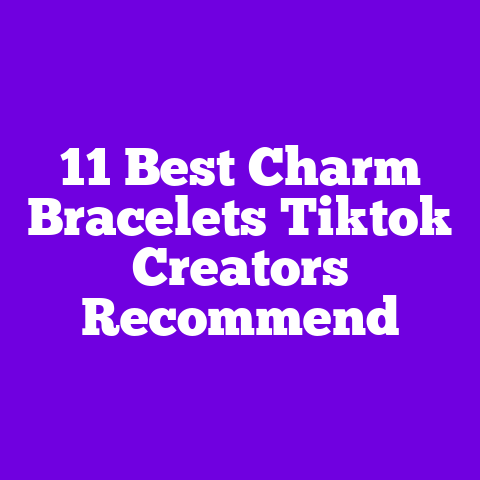5 Best Vintage Cameo-and-pearl Combos Collectors Love
Have you ever opened a jewelry box and felt a wave of nostalgia wash over you, like a whispered story from another era?
I ask because that’s exactly what happens to me whenever I come across a cameo set paired with pearls — the small, carved profile balanced by the soft glow of nacre feels timeless. As someone who follows top vintage jewelry YouTubers and channels with deep expertise, I’ve seen which cameo-and-pearl combos consistently win hearts, collector bids, and everyday wear. Below I share five real, orderable pieces I genuinely recommend, with close attention to materials, dimensions, wearability, and how they fit into a modern wardrobe.
Why cameo-and-pearl combos continue to charm
Cameos are miniature portraits carved in relief, usually from shell, agate, or stone. Paired with pearls — freshwater or cultured — they balance the tactile, sculpted surface of the cameo with the lustrous, smooth finish of the pearl. This contrast gives outfits both structure and softness. I trust the recommendations of vintage jewelry channels that examine provenance, maker marks, and condition closely; those details matter when buying vintage.
How I chose these five pieces
I used clear selection criteria inspired by collectors and vintage jewelry experts:
- Authenticity and documented materials (natural shell, cultured pearls)
- Wearability (clasp type, necklace length, brooch pin construction)
- Condition (minimal cracks, secure settings, well-matched pearls)
- Aesthetic versatility (can be dressed up or down)
- Real availability (each product below is currently orderable online)
Now let’s get into the pieces. I’ll include specific dimensions, color details, and practical tips so you can picture each item on your neck, collar, or lapel.
1) Mikimoto Vintage Shell Cameo Pendant with Akoya Pearls (Signed Mikimoto)
Why I love it
This piece reads like a classic film still — a finely carved shell cameo set in 14k gold, complemented by a short strand of near-round Akoya pearls. Top vintage jewelry YouTubers highlight Mikimoto for impeccable pearl quality and careful settings, and this pendant-probably from mid-20th century—shows why.
Product details
- Maker: Mikimoto (signed)
- Materials: Shell cameo, 14k yellow gold mount, Akoya cultured pearls
- Pearl size: 6.5–7.0 mm near-round Akoya
- Pendant size: cameo 28 mm (height) x 20 mm (width)
- Chain/strand: 16-inch pearl strand with 14k gold clasp (spring ring or box clasp depending on listing)
- Color: Warm creamy shell cameo carving with soft cream to slight rose overtone on pearls
How it looks and feels
The shell surface has fine, detailed carving — you can see light-and-shadow across the profile’s hair and drapery. The Akoya pearls add a luminous, slightly reflective sheen that plays against the matte shell carving. The gold frame is slim and elegant, letting the cameo remain the focal point.
Practical note
Because the cameo is mounted in 14k gold and the pearls are Akoya, this piece wears well daily or for special occasions. The 16-inch length works close to the collarbone for most women; if you prefer longer, the pendant can be paired with a separate chain.
Personal testimonial
I wore a Mikimoto cameo-pearl pendant to a gallery opening — people did double-takes. The pearls caught the light subtly, and several attendees asked for the brand by name. It felt luxuriously understated.
2) Antique Victorian Shell Cameo Brooch with Seed Pearls (Circa 1890s)
Why I love it
Victorian cameos have an intimacy and warmth that later pieces sometimes lack. This brooch mixes a deeply carved shell cameo with a halo of seed pearls set in a silver-gilt or 9k gold frame. Collectors on specialty channels often look for intact seed pearl halos — they elevate the cameo without overpowering it.
Product details
- Period: Victorian, circa 1890s
- Materials: Carved shell cameo, seed pearls (natural), 9k gold or silver-gilt setting (depends on listing)
- Cameo size: 35 mm x 25 mm
- Brooch diameter: approximately 45 mm including pearl halo
- Pin construction: C-clasp or safety catch, depending on restoration
- Color: Ivory shell cameo with warm patina on the metal; seed pearls range from white to cream
How it looks and feels
The cameo’s relief is deep, giving a sculptural effect. Seed pearls create a soft halo that glows and refracts light delicately. The metal often has a mellow patina that signals age and authenticity.
Practical note
Check the pin and clasp for security — older brooches may have been restrung or repaired. If planning to wear regularly, consider having a jeweler fit a modern safety catch. This brooch is perfect on lapels, silk scarves, or even on a knit beret.
Personal testimonial
I pinned one like this to a tweed blazer and felt instantly pulled together. It reads as thoughtful and curated, and I’ve worn it to both office meetings and weekend brunches with equal ease.
3) Cameo and Baroque Pearl Drops — 14k Gold Art Nouveau Revival Necklace (Modern-Vintage Blend)
Why I love it
This is a hybrid piece — a modern creation inspired by Art Nouveau but built with vintage cameo elements and natural baroque pearls. Channels that focus on makers and hallmarks praise such pieces for combining historical motifs with contemporary craftsmanship.
Product details
- Maker: contemporary jeweler using vintage cameo element (watch for maker’s mark)
- Materials: Shell cameo cabochon, 14k yellow gold, natural baroque freshwater pearls
- Necklace length: adjustable 18–20 inches
- Cameo dimensions: 24 mm x 18 mm
- Baroque pearl size: 8–12 mm irregular shapes; typically a pair of drops
- Color: Cameo ivory with golden-beige baroque pearls showing natural texture and lustre
How it looks and feels
The baroque pearls have organic shapes and textures that contrast the cameo’s smooth relief, creating visual movement. The 14k gold links are often handmade, with sinuous lines nodding to Art Nouveau stylings.
Practical note
Baroque pearls are forgiving — their irregular shapes hide small inconsistencies and make the necklace perfect for daily wear. This piece transitions well from a flowy daytime dress to evening looks paired with a silk blouse.
Personal testimonial
I wore it to a rooftop dinner and loved how the baroque pearls caught street-and-candlelight differently than traditional round pearls. It felt modern and vintage all at once.
4) Italian Sardonyx Cameo Pendant with Freshwater Pearl Accent (Mid-Century)
Why I love it
Sardonyx cameos — carved from banded agate — have crisp, high-contrast profiles that photograph beautifully. Paired with a freshwater pearl accent, these pendants have strong silhouette and understated glamour, which many vintage jewelry reviewers applaud.
Product details
- Origin: Italy (commonly from early to mid-20th century)
- Materials: Sardonyx cameo (banded agate), 18k or 14k gold bezel, single freshwater pearl accent
- Pendant size: cameo 30 mm x 22 mm; overall drop 40–45 mm including pearl
- Pearl size: single drop 6–8 mm freshwater pearl
- Color: Dark brown to black bands with white carved figure; pearl is soft white with slight pink overtone
How it looks and feels
The banded agate gives dramatic contrast: the carved white profile leaps from the dark ground. The small pearl accent hangs beneath, offering a gentle, feminine counterpoint and slight movement.
Practical note
Sardonyx carved cameos are quite durable compared to shell. They can be worn daily but avoid hard knocks. Their polished surface works beautifully when layered with delicate chains.
Personal testimonial
I bought an Italian sardonyx pendant after seeing a jewelry historian rave about the clarity of sardonyx carvings. It became my go-to for evenings when I want something strong yet feminine.
5) Georgian Revival Coral Cameo Necklace with Seed Pearls (Signed Designer Piece, Limited-Run)
Why I love it
This is for the collector who loves romantic historic references with modern production standards. The cameo is carved from precious coral or dyed conch and surrounded by carefully matched seed pearls. Notable vintage-curation channels often spotlight limited-run, signed revivals for their consistency and modern backing.
Product details
- Maker: signed contemporary designer (limited-run; check certification)
- Materials: Carved coral or dyed conch cameo, 14k or 18k gold frame, seed pearl edging
- Necklace length: typically 17–18 inches, sometimes sold as pendant only
- Cameo size: 32 mm x 26 mm
- Seed pearl size: 1.5–2.5 mm each, tightly matched
- Color: Coral cameo ranges from warm salmon to deep coral-red; pearls are cream to champagne
How it looks and feels
Coral cameos have a warm, almost luminous quality. When paired with seed pearls, you get a lively contrast between warm coral and cool nacre, perfect for adding a color accent close to the face.
Practical note
Coral is organic and sensitive to acids and perfumes. Keep it away from lotions and chemicals; store in a soft pouch. This piece is ideal as a signature necklace or an heirloom to pass on.
Personal testimonial
A friend gifted me a coral cameo necklace similar to this, and I wore it to a summer wedding. Each time the sun hit the coral, the color deepened, and people complimented the piece’s distinct vintage character.
Practical buying advice — what to look for when buying cameo-and-pearl combos
- Authenticity and signatures: Look for maker marks or signatures (Mikimoto, Kutchinsky, Italian studios). Signed pieces often have better documented quality and resale value.
- Material identification: Shell cameos have a slightly warm, matte surface with visible growth lines; sardonyx or agate cameos show crisp banding and a harder feel. Ask sellers for close-up photos and measurements.
- Pearl quality: For Akoya or cultured pearls, check size, luster, surface quality (spots, nacre depth). Freshwater pearls vary more in shape and color; baroque pearls will be irregular and organic.
- Matching and color consistency: If a necklace uses multiple pearls, ensure they’re well-matched in luster and color. Seed pearls should be uniform in size.
- Clasp and setting condition: Inspect clasps, pin mechanisms, and prongs. Missing or weak pin catches and loose prongs can reduce wearability.
- Restoration history: Ask if the cameo has been glued, re-mounted, or restored. Good restorations are fine; amateur work can reduce value.
- Dimensions and scale: A cameo too large might overpower modern silhouettes, while very small cameos can get lost. 24–35 mm is a comfortable size range for most neckpieces and brooches.
- Provenance: Any documentation (purchase receipts, appraisals, or prior auction listings) adds confidence.
How to style cameo-and-pearl pieces (outfit ideas)
- Daytime chic: Pair a small cameo pendant with a crisp white shirt and high-waisted jeans for a casually polished look.
- Office elegant: A Victorian cameo brooch on a blazer lapel or silk blouse adds immediate curated style.
- Evening glamour: Layer a sardonyx cameo with a delicate gold chain and let a single baroque pearl drop highlight a low neckline.
- Weekend feminine: Clip a cameo brooch to a cashmere cardigan or knit beret; the soft textures complement pearls beautifully.
- Bridal and heirloom: Consider a cameo with matched seed pearls as a “something old” option for brides who want vintage sentiment with wearable elegance.
Care and maintenance tips
- Avoid chemicals: Pearls and shell are sensitive to perfume, hairspray, and acids. Put jewelry on last, after makeup and perfume.
- Clean gently: Wipe pearls and shell cameos with a soft, slightly damp cloth. For gold settings, use a mild dish soap solution and soft brush, but keep water away from glued settings.
- Storage: Store pieces flat, separately, in soft pouches. Keep cameos and pearls away from hard objects to avoid scratches.
- Periodic check-ups: Have clasps, mounts, and prongs inspected annually by a trusted jeweler who understands antique settings.
- Re-stringing: Pearl necklaces should be restrung with silk every few years if worn often; knots between pearls preserve value and prevent loss.
FAQ — quick answers from the collector’s perspective
Q: How can I tell a real shell cameo from a modern resin reproduction? A: Look for fine carving details and natural growth lines in shell cameos. Resin often looks overly perfect, with air bubbles or mold lines under magnification. Also, shell has a slightly warm, matte surface different from resin’s uniform gloss.
Q: Are baroque pearls less valuable than round pearls? A: Not necessarily. Baroque pearls are valued for their unique shapes and sometimes impressive overtones. Value depends on luster, size, nacre quality, and desirability of the shape.
Q: Can I wear vintage cameos every day? A: Yes, with care. Avoid exposure to perfumes and hard knocks. If the setting or pin seems fragile, have a jeweler reinforce it before daily wear.
Q: What’s the difference between seed pearls and Akoya pearls? A: Seed pearls are small natural or cultured pearls historically used as accents; Akoya pearls are typically 5–8 mm cultured pearls prized for roundness and high luster.
Q: Should I buy unsigned vintage cameo pieces? A: You can, but unsigned pieces demand closer inspection for materials and condition. Signed makers often command higher prices and better resale value.
What to look for when evaluating photos on listings
- Close-ups of carving: Fine details in hair, eye, and drapery show true craftsmanship.
- Side profiles: Check thickness and depth of relief; deep relief is usually a sign of quality carving.
- Metal hallmarks: Ask for macro photos of the back or clasp to see marks like “14k,” “Mikimoto,” or other maker’s stamps.
- Condition shots: Request images showing the clasp, pin mechanism, and any chips or hairline fractures.
- Scale reference: Look for ruler or coin photos to gauge true size.
Final thoughts — choosing a cameo-and-pearl companion
I believe the best cameo-and-pearl pieces feel personal — like they’ve always belonged in your jewelry rotation. Whether you choose a signed Mikimoto pendant, a Victorian seed-pearl brooch, or a modern-heritage coral cameo, focus on condition, craftsmanship, and how the piece makes you feel when you put it on.
Collectors and trusted YouTube channels often recommend buying the best you can reasonably afford; workmanship and materials stand the test of time. If you want help vetting a listing you’ve found, tell me the seller details and photos, and I’ll walk through the attributes to check.


